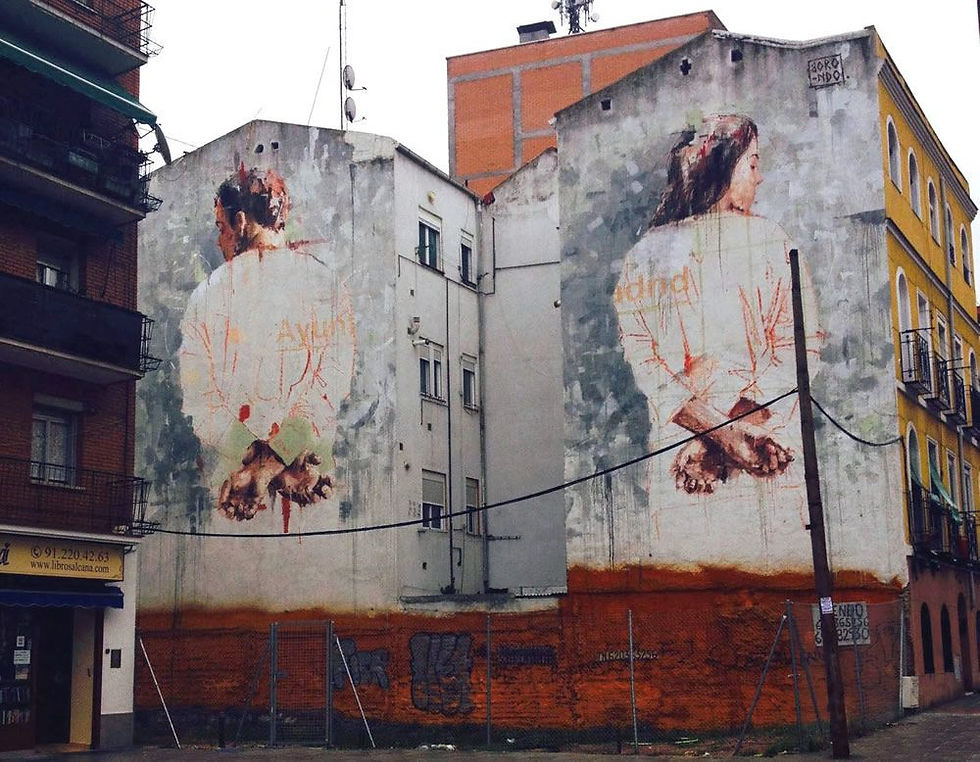
GONZALO BORONDO
FOR MORE INFORMATION, CV/BIO/PDF,
WORKS FOR COMMISSIONS AND AVAILABLE
WORKS FOR SALE: magidson124@gmail.com
Piercing, dark eyes, short hair, Borondo has everything of a young punk in rebellion with his world. He inscribed his mark on the walls of Madrid. His style combines the techniques of graffiti and classical painting. With a rendering closer to a charcoal drawing. After an academic training in Fine Arts, Borondo spent a year in 2012 through the Erasmus program in Rome. On his return to Madrid, he seeks to break the traditional codes of street art, also moves away from pop culture and offers a new vision of the genre. The Madrilenian who masters to perfection the techniques of aerosol and roller painting also scratches the abandoned windows of shops which are emptying little by little and scrutinize what is happening inside
Spain is hard hit by the economic crisis. The shopping streets draw their iron curtains. Borondo takes the opportunity to wake up strange and ghostly creatures on these windows using his scrapers. His technique known as "glass scratching", glass scraping, opens up new perspectives to street art and reinvents the genre. "I find that quite poetic, the glass has something magical ", testifies Borondo. Clever, the artist tries to remain discreet and not to get caught. His technique contributes to this. "It's a trick to not get arrested by the police: I'm just erasing paint on a window ".
"Dialogue with the place"
Street poet, Borondo settles down with a sheet in hand, in front of dilapidated walls, abandoned shop windows, bus shelters, telephone booths or illuminated billboards. On the walls, he paints portraits with a roller or spray. His perfect technical mastery of his mediums allows him to explore a very wide and unique style palette.
Like a jet of mikado, it can make faces appear with a few strokes fired with a spray can. On the glass, he passes a first coat of paint then swaps the brush for the scraper. He plays with light and shadow. Faces, figures and bodies then appear. Scenes of life, characters on the edge of the world. The highlighting is impressive. And yet, the silhouettes know how to remain discreet. "They must be part of the place," insists Borondo. "You can't walk into a place and put something prepared, really flashy like that." You have to dialogue with the place, stay in your place, discreet. There are already too many pubs in the streets ”.
Borondo's work comes to life in the street without distorting the medium. Sometimes it is even camouflaged. The artist manages to combine details of the natural setting with his work. Thus, a window, a door, a ventilation cage connect two worlds, the real and the virtual. “I walk around, a poetic image comes to me and I try to give it shape. I don't know why I'm doing this, it's spontaneous, natural. I love the street because it's a place where anything can happen. "
"You don't make art to be a civil servant"
Borondo now exhibits his works in galleries. In 2013, he was invited to the Galerie Itinerrance in the 13th arrondissement of Paris. Recently, the municipality of Madrid also commissioned works from him. And if one could believe that these orders are far enough from the values of street art, more consumerist than artistic, Borondo assumes. He takes advantage of his notoriety to finance his trips and pursue his artistic creation. “ You don't do art to be a civil servant, you do that to be free, ” he says.



















